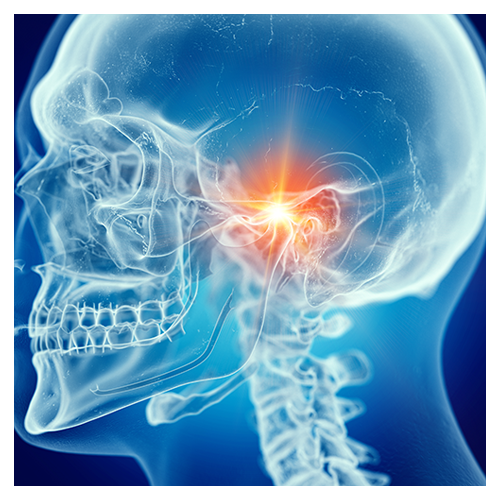What is TMJ?
It is a common misconception that a person is diagnosed with “TMJ” when in fact we all have TMJ – two, actually.
The Temporomandibular Joints (TMJ) are located directly in front of the ear, on both sides of the skull. The muscles and ligaments work together to allow the jaw to open and close, giving us the ability to chew, speak, and more.
People may experience craniofacial pain, headaches, migraines, facial neuralgias, musculoskeletal pain, or a combination of all due to TMJ Disorder.
About TMD
To start, let’s talk about the anatomy of our jaw joints. The joints connect the mandible to the temporal bone on each side of our skulls. When we open our mouths, the ends of the lower jaw (condyles) glide along the joint socket and return back upon closing our mouths. To create this smooth gliding motion, there is a soft disc lying between the condyles and temporal bones.
In healthy jaw joints, the jaw moves smoothly up and down and side to side, without pain, popping, or noises. If you are unable to do this, it is a good sign that you may have a jaw joint disorder.
Think of the two joints as one unit, moving on a single bone, the mandible. A problem with one joint means that the other isn’t functioning properly either.
Types of TMJ Disorders
TMD is an all-encompassing term that means there is some issue or condition leading to your jaw not functioning properly. TMD is a group of disorders that cause pain and dysfunction of the jaw joints and the muscles that control their structure and movement.
Conditions of the jaw joints widely vary, but some types of disorders fall under these categories:
- Myofascial pain
- Internal derangement
- Arthritis/degenerative disorder
- Congenital disorders
Multiple conditions could be present at one time, and this is often the case.
TMD is Not a Genetic Disorder
Another common mix-up is that someone got their TMD from a member of their family. Think of it this way, the condition of TMD is not passed down genetically; however, certain congenital disorders can put someone at higher risk for developing a jaw joint disorder.
Most often, temporomandibular joints start out as normally growing and developing structures. Somewhere along the way, a person sustains trauma to the joint or develops a condition, such as arthritis, that leads to TMD. Sleep Breathing Disorders, such as Obstructive Sleep Apnea, can also contribute to the development of a TMJ Disorder, or vice versa.
All Ages Can Suffer From TMD
A person of any age can develop a jaw joint disorder, even newborn babies. Explore the symptoms associated with a Temporomandibular Joint Disorder and how they may be different for various age groups.
